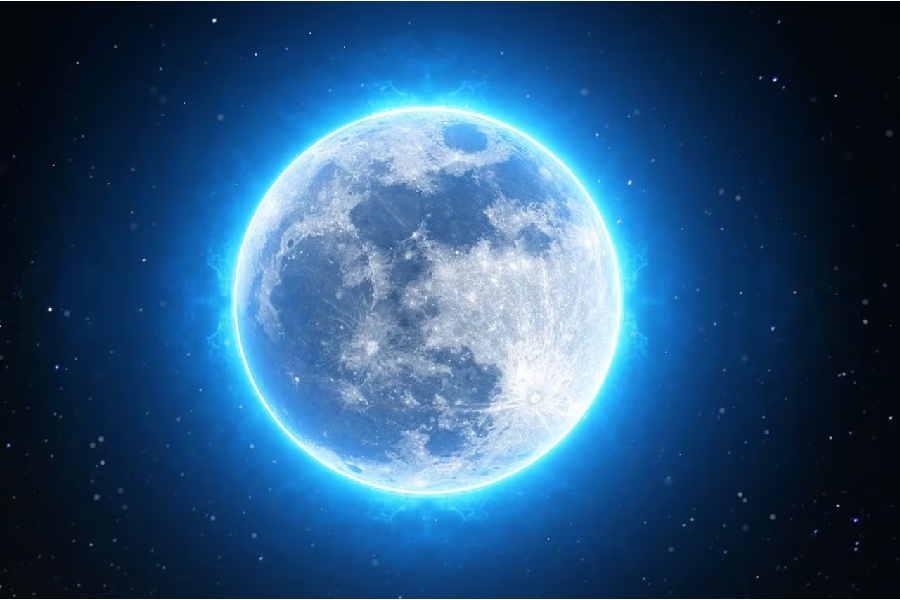When we look up at the night sky, the Moon’s familiar glow comforts amid the twinkling stars. Most nights, the Moon appears its usual bright white. But on rare occasions, it transforms into an eerie blue. So, what is a Blue Moon, and what causes this odd phenomenon?
In this article, we will unravel the puzzle behind the Blue Moon. We will explore what factors produce its unusual hue compared to a normal full moon. Let us discover how the calendar, moon phases, seasons, and more conspire to create this spectacular sight.
As we learn when to spot the next Blue Moon, you will gain a fresh appreciation for the moon’s subtleties, revealed by science and myth surrounding its dramatic blue aura. Is the Blue Moon really blue? Keep reading to find out!

What Is a Blue Moon?
The term “Blue Moon” refers to the second full moon occurring in the same calendar month. The origin of the term traces back to a misinterpretation of older definitions.
In the Maine Farmer’s Almanac, “Blue Moon” meant the third full moon in a season with four moons. But the original meaning was lost, leaving today’s definition focused on a month with two full moons. So, the Blue Moon is not really blue in color.
Why is it called the blue moon? It likely represents the rarity or absurdity of having two full moons in one month. The extra full moon in a month causes the second one to be called a Blue Moon based on the modern definition. Their infrequency contributes to the mystique around these uncommon celestial events.
How often is a Blue Moon?
NASA’s perspective
According to NASA, a Blue Moon happens roughly once every two and a half years. This is based on the modern definition of a Blue Moon, which refers to the second full moon in a single calendar month.
Most years have 12 full moons that occur approximately once per month. But some years contain thirteen full moons. When that happens, the extra full moon during a month causes the second one to be called a Blue Moon.
Since the cycles of the lunar and solar calendars align in this way every two and a half years on average, that’s the frequency with which Blue Moons are observed from Earth. NASA provides clear data on the patterns that give rise to these uncommon extra full moons.
Calendar-Based Blue Moons
Seasonal and monthly definitions
There are two calendar-based definitions of a Blue Moon. Originally, it referred to the third full moon in a season containing four full moons. This is the seasonal definition.
The modern monthly definition is the second full moon within one calendar month. These definitions arise from quirks of aligning the lunar and solar calendars.
Frequency in the modern calendar
In the modern calendar, Blue Moons happen roughly once every two to three years. The modern definition depends solely on when two full moons fall in one month. This is more regular than the seasonal definition. The exact time spans between Blue Moons follow predictable cycles.
So, Blue Moons are uncommon but not extremely rare in the current solar-based calendar. Their frequency results from periodic alignments between the 12-month solar year and the lunar cycle of full moons.
Astronomical Causes of a Blue Moon
Lunar phases and cycle
The Moon goes through regular phases in its 29.5-day lunar cycle. It progresses from the new moon to the full moon, then back to the new moon again. Usually, one lunar cycle aligns with one calendar month. But the lunar cycle is shorter than calendar months.
Occasionally, a full moon falls early in a month, and the next lunar cycle’s full moon falls late in the same month. This results in two full moons in a single calendar month – a Blue Moon.
Factors leading to occasional occurrence
The main factors leading to a Blue Moon are the mismatched lengths of lunar and calendar months. Lunar cycles don’t fit exactly into the 12-month calendar. When a lunar cycle is shorter than normal, the extra full moon falls into the prior month, leaving two full moons that month.
While not actually blue, the second full moon does stand out as unique. Its occurrence results from the periodic alignment of the lunar cycle and solar calendar.
Notable Blue Moons in History
Famous instances
Some famous Blue Moons coincided with major events. In 1999, a Blue Moon fell on New Year’s Eve, ushering in the new millennium.
Another in 2018 occurred during a lunar eclipse visible in eastern Asia. The year 1946 saw two Blue Moons in January and March. These represent some of the most notable Blue Moons in recorded history.
Cultural and historical events
Blue Moons have inspired art, stories, and legends across cultures. Native American tribes named each full moon and ascribed the Blue Moon special powers. In the 1930s, the phrase “once in a Blue Moon” emerged, reflecting the moon’s rarity.
More recently, scientists have studied if the added light of a Blue Moon impacts wildlife behavior. Though not truly rare, Blue Moons hold an enduring mystique in culture and history. Their alignment with major events adds to their aura of mystery and significance.
Conclusion
Gaze up at the night sky with newfound wonder. We illuminated the science and lore behind the Blue Moon’s elusive beauty. We traced its calendar-based definitions and the astronomy enabling its occasional appearance and explored famous instances linking Blue Moons indelibly to culture and history.
So, what is a Blue Moon? As discovered, it is a convergence of celestial and calendrical alignments. Its rarity renders it mysterious, yet predictive patterns allow anticipation of the next sighting.
Luckily, individuals may glimpse that eerie blue glow themselves. As they welcome its allure, this guide aims to deepen their appreciation for the Moon’s many subtleties, including its rare Blue Moon persona, which inspires awe and imagination.
